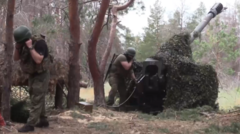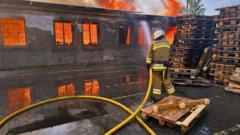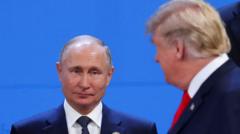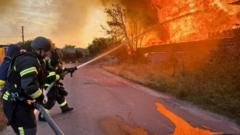Amid Russia's efforts to open a new front in eastern Ukraine, challenges mount as its advancing troops encounter fierce resistance and confront logistical hurdles.
Russia's Stalled Offensive in Ukraine: Challenges and Resistance

Russia's Stalled Offensive in Ukraine: Challenges and Resistance
As drone and missile attacks from Russia escalate, its military attempts to gain ground in Ukraine face substantial opposition.
Russia has ramped up its drone and missile assaults on Ukraine to unprecedented levels while claiming modest progress on the ground. In the past month, Russian forces have reportedly gained 556 square kilometers (215 square miles) of territory, marking their most significant land acquisition of 2023. This expanse is approximately four times the size of Liverpool and comparable to the area of Chicago.
The Kremlin's strategy appears to involve severing supply lines for Ukrainian troops and creating a buffer zone along Ukraine's northern border. However, the advance is proving slow, and at the current pace, it would take Russia over 70 years to occupy all of Ukraine.
Russian operations have primarily centered on three areas: the northeastern Sumy region, the eastern cities of Pokrovsk and Kostyantynivka, and a new front west of Pokrovsk. In the Sumy region, Russian forces managed to push approximately 10-12 kilometers (6-7.5 miles) but have been met with staunch resistance that has stalled their progress.
President Vladimir Putin strives to establish a safety buffer following Ukraine's previous advances, notably in Kursk territory. Yet, Russian forces are currently mired in protracted battles for minor border villages, which continuously change hands. This inconsistency in territory control highlights the challenges of sustaining their offensive without significant reinforcements.
Military analysts have observed that the Russian strategy may aim to exhaust Ukrainian defenses by stretching their forces thin along the extensive 1,200-kilometer front line. Pokrovsk, a critical focal point, has seen the concentration of around 111,000 Russian troops, yet large-scale assaults are scarce. Instead, Russian forces often employ small infantry units that engage Ukrainian positions in a marathon of attrition, resulting in significant casualties for both sides.
Reports suggest that Russian casualties may exceed 1,000 soldiers daily, although independent verification is lacking. The objective in eastern Ukraine appears to encompass creating a "cauldron" to encircle and compel Ukrainian forces in Pokrovsk and Kostyantynivka into retreat.
Currently, Russian troops are making efforts to establish footholds between these cities for a potential attack. However, military observers argue that their advance has slowed, with earlier attempts from other directions faltering.
Recent Russian advances in the Novopavlivske direction pose the most substantial threat to Ukrainian defenses, with reports of the acceleration bringing them closer to the Dnipropetrovsk region. However, Ukrainian officials quickly counter any claims of substantial territorial gains by Russian forces.
Despite these challenges, Ukrainians are facing mounting pressure on the front lines, primarily due to Russian drone attacks aimed at disrupting their supply routes. Ukrainian artillery units have increasingly encountered difficulties delivering essential supplies, evacuating injured personnel, and maintaining troop rotations.
Additionally, staff sergeant Viktor Pyasetskyi has noted that Russian drones, capable of flying hundreds of kilometers undetected, are eroding previously secure supply routes. The aim extends beyond military gains; it seeks to diminish civilian morale by systematically targeting civilian infrastructure.
As the conflict continues, both sides exhibit stalemate characteristics, where the struggle for territorial gains is coupled with heavy human costs and operational obstacles.
The Kremlin's strategy appears to involve severing supply lines for Ukrainian troops and creating a buffer zone along Ukraine's northern border. However, the advance is proving slow, and at the current pace, it would take Russia over 70 years to occupy all of Ukraine.
Russian operations have primarily centered on three areas: the northeastern Sumy region, the eastern cities of Pokrovsk and Kostyantynivka, and a new front west of Pokrovsk. In the Sumy region, Russian forces managed to push approximately 10-12 kilometers (6-7.5 miles) but have been met with staunch resistance that has stalled their progress.
President Vladimir Putin strives to establish a safety buffer following Ukraine's previous advances, notably in Kursk territory. Yet, Russian forces are currently mired in protracted battles for minor border villages, which continuously change hands. This inconsistency in territory control highlights the challenges of sustaining their offensive without significant reinforcements.
Military analysts have observed that the Russian strategy may aim to exhaust Ukrainian defenses by stretching their forces thin along the extensive 1,200-kilometer front line. Pokrovsk, a critical focal point, has seen the concentration of around 111,000 Russian troops, yet large-scale assaults are scarce. Instead, Russian forces often employ small infantry units that engage Ukrainian positions in a marathon of attrition, resulting in significant casualties for both sides.
Reports suggest that Russian casualties may exceed 1,000 soldiers daily, although independent verification is lacking. The objective in eastern Ukraine appears to encompass creating a "cauldron" to encircle and compel Ukrainian forces in Pokrovsk and Kostyantynivka into retreat.
Currently, Russian troops are making efforts to establish footholds between these cities for a potential attack. However, military observers argue that their advance has slowed, with earlier attempts from other directions faltering.
Recent Russian advances in the Novopavlivske direction pose the most substantial threat to Ukrainian defenses, with reports of the acceleration bringing them closer to the Dnipropetrovsk region. However, Ukrainian officials quickly counter any claims of substantial territorial gains by Russian forces.
Despite these challenges, Ukrainians are facing mounting pressure on the front lines, primarily due to Russian drone attacks aimed at disrupting their supply routes. Ukrainian artillery units have increasingly encountered difficulties delivering essential supplies, evacuating injured personnel, and maintaining troop rotations.
Additionally, staff sergeant Viktor Pyasetskyi has noted that Russian drones, capable of flying hundreds of kilometers undetected, are eroding previously secure supply routes. The aim extends beyond military gains; it seeks to diminish civilian morale by systematically targeting civilian infrastructure.
As the conflict continues, both sides exhibit stalemate characteristics, where the struggle for territorial gains is coupled with heavy human costs and operational obstacles.






















